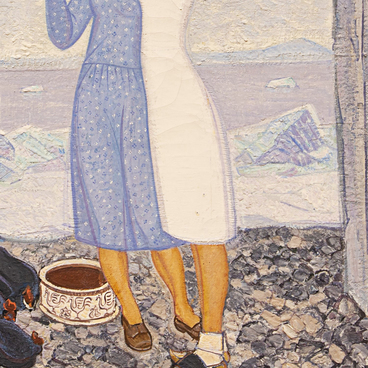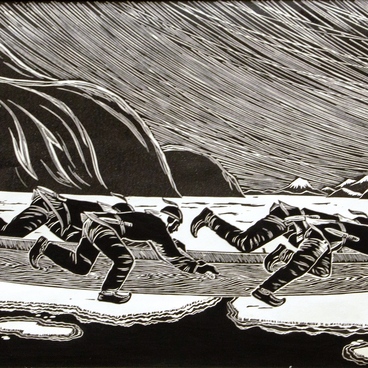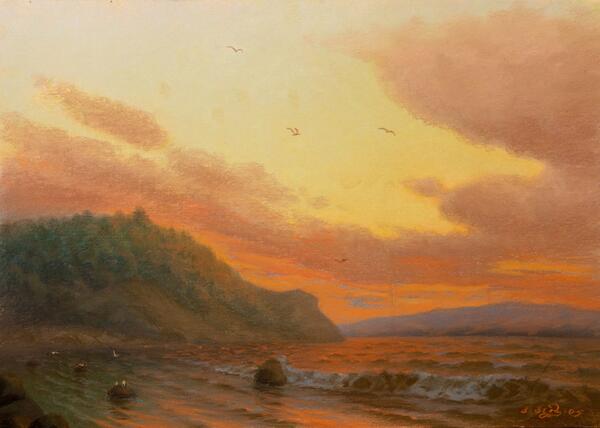Valery Yakovlevich Verenyov was born in 1944 in the village of Zherebtsovo on the left bank of the Amur River. From an early age he had a lyrical perception of the world, a love of nature and an aspiration to capture its beauty.
After finishing seven years of school, Valery Verenyov moved several times and changed several occupations. His first meaningful encounter with the artistic sphere happened between 1963 and 1964 at the art school in Komsomolsk-on-Amur, where at the time Verenyov resided and worked. There, students of the evening classes were taught art history, drawing, composition and painting.
He started serving in the army in 1964, and it was during that time of his life that he made his first pencil sketches and watercolor studies from life while staying in the Lower Amur region. The commanders noticed the young man’s talent and entrusted him with decorating the premises. For the next few years, while being engaged in various regions, the artist practiced art design and honed his skills and personal style.
In 1970, Valery Verenyov had his first solo exhibition, and in 1972, following the advice of a fellow artist Veniamin Lvovich Shkrab, the young painter continued his studies by becoming an external student of the department of painting and drawing at the Moscow National University named after Nadezhda Krupskaya. Later, from 1986 to 1994, he attended the workshop of Nikolay Nikolayevich Chuvakhin. During that same period, Valery Verenyov opened his own art studio called “Rainbow” and many of his students became talented artists.
In 2000, Valery Yakovlevich Verenyov became a member of the Artists’ Union and since then has devoted himself to public activities and artistic endeavors. His works have participated in many exhibitions and been displayed in museums and private collections in Russia, Japan, USA and Canada.
Most of Valery Verenyov’s landscapes were created using pastel: this fragile art material is the best choice to reflect effects of light and minute transitions of color.
“Waves of Amur” is one of the artist’s many works that are dedicated to the great river. The sparkling silvery waves, the blue and purple hills in the distance, and the subdued tones of the sunset sky create a dreamy, romantic mood and echo the admiration for nature — things that are so characteristic of the painter’s approach.
After finishing seven years of school, Valery Verenyov moved several times and changed several occupations. His first meaningful encounter with the artistic sphere happened between 1963 and 1964 at the art school in Komsomolsk-on-Amur, where at the time Verenyov resided and worked. There, students of the evening classes were taught art history, drawing, composition and painting.
He started serving in the army in 1964, and it was during that time of his life that he made his first pencil sketches and watercolor studies from life while staying in the Lower Amur region. The commanders noticed the young man’s talent and entrusted him with decorating the premises. For the next few years, while being engaged in various regions, the artist practiced art design and honed his skills and personal style.
In 1970, Valery Verenyov had his first solo exhibition, and in 1972, following the advice of a fellow artist Veniamin Lvovich Shkrab, the young painter continued his studies by becoming an external student of the department of painting and drawing at the Moscow National University named after Nadezhda Krupskaya. Later, from 1986 to 1994, he attended the workshop of Nikolay Nikolayevich Chuvakhin. During that same period, Valery Verenyov opened his own art studio called “Rainbow” and many of his students became talented artists.
In 2000, Valery Yakovlevich Verenyov became a member of the Artists’ Union and since then has devoted himself to public activities and artistic endeavors. His works have participated in many exhibitions and been displayed in museums and private collections in Russia, Japan, USA and Canada.
Most of Valery Verenyov’s landscapes were created using pastel: this fragile art material is the best choice to reflect effects of light and minute transitions of color.
“Waves of Amur” is one of the artist’s many works that are dedicated to the great river. The sparkling silvery waves, the blue and purple hills in the distance, and the subdued tones of the sunset sky create a dreamy, romantic mood and echo the admiration for nature — things that are so characteristic of the painter’s approach.


